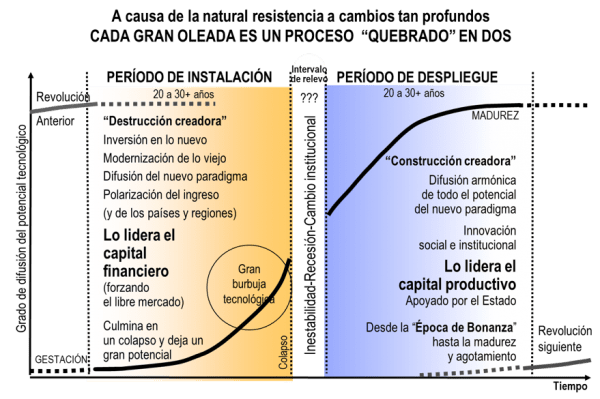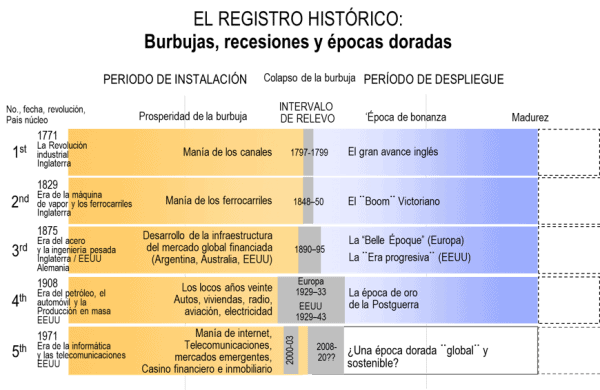
These days, the only thing we know for sure is that we are at the crossroads for a potential new golden age in our evolution as a species. The recent crises we’ve been through. New, disruptive information and communications technologies permeating society just before that. These have positioned us before the gradient change in a global lifestyle transition. We have the power to use this position to our advantage or to forge ahead in an age of uncertainties, inequalities, conflicts, and, for a few, exploitation of all this uncertainty.
What is going on?
Over the last decade, we’ve been through several major events in the economic, social, and political arenas, both in Spain and in the West. We have no convincing explanations for these. At the start of the century, financial activity, which has turned into a real gambler’s paradise, managed the goods and services markets in the production-based economy, and this resulted in decisions leaning towards austerity and conservatism in the political sphere.
This “capital market government”, which creates bubbles, means that the economy, added value, and industry take second stage to a desire for rapid growth for only a few. This creates deflation, unemployment, income inequality within and between countries, persistent and growing inequality, economic migration, and ultimately, social unrest, xenophobia and the emergence of messianic leaders. The crises we’ve been through lately, especially the current COVID19 crisis, are a sign of the end of that era and the beginning of a new one.
Technological revolutions throughout history
Renowned expert Carlota Pérez says that we are in the same historical moment as the 1930s. Both then and now are similar times of great opportunity for our society, our economy, and our planet. The last few years have seen an intense crisis, which is fundamentally generated by a technological and industrial revolution. This has brought us a series of new knowledge and technologies, the common denominator of which is technologies called Information and Communications Technologies (ICT).
This digitization ultimately transforms the way we live, consume, and produce goods and services. But up until now, this revolution has been messy, uneven, and forced, as so-called technological revolutions always are at first. And this is why new technology and its applications always run on a world and a culture built by the previous revolution – in our case, the analog revolution.
 Chart by Carlota Pérez, 2016
Chart by Carlota Pérez, 2016
Every time there’s this clash between a new technology and an old world through which it spreads, the process has repeatedly ended in a financial bubble and a global crisis. This has led to most of us hitting rock bottom as individuals, organizations, sectors, and society.
The good news I mentioned is that we have historically emerged from these crises with a second era of technological revolution. In these “golden ages,” we are collectively able to extend the benefits associated with the new technologies to most of society in an orderly manner, finally reducing inequalities and involving all social and economic agents in this transformation.
 Chart by Carlota Pérez, 2016
Chart by Carlota Pérez, 2016
In the 1930s, as seen in hindsight, the technological revolution essentially took place in the electrical, chemical, aerospace, and automotive field and in construction. That golden age, ending with the crises of our century, was based on mass production and consumption of industrial products. The sedan and household appliances led the way for a significantly more modern, more comfortable home for most of the United States and then the West. This resulted in better quality of life of many people, especially a large middle class who could and should buy a car, a refrigerator, a dishwasher, and so on for their new home farther from the city center. At the same time, this change in “lifestyle” was a huge boost to the economy based on mass production and the sale of these new star products, which were deemed essential in that golden age.

The last transition, which took place during the last century, is represented by these images of the horse-drawn carriage being replaced by the combustion engine and car. These new trends in mobility were caused in part by the suburbanization of our cities.
Levers for opportunity
Today, we have a new opportunity before us to kick-start our golden age. In this case, the new information and communications technologies, along with the urgency of climate change and new social realities (such as the current pandemic), are called upon to change our lives, how we consume and produce goods, services, and experiences. The new lifestyle is radically more connected, more collaborative, healthier, and consumes less energy and natural resources. The strategy once again involves working through a transition towards new notions of society and economy in an orderly, inclusive, and participatory way. The new digital age should offer improvements in quality of life and health for most of us, a significantly lower impact on the climate and the planet, and economic growth across many sectors, thus generating decent employment for the entire working population.
This new version of economic activity will have to be shared by humans and robots (“co-botization”), and it will have to prioritize intangible services over the production of tangible goods. We will see the useful life of industrial products expand, sectors and professions growing into maintenance and personalization activities, and improvements in the customer experience. This is our generation’s great opportunity, following our great crisis.
We’re at the end of an era, as indicated by a series of obvious symptoms that are transforming our ways of life during the COVID19 crisis. This is a window of opportunity for the country to set a course towards the new “good life” of a green, digital society, along with the values, lifestyles, and technologies that will bring us a better existence and new competitive markets for our productive sectors. The fact that applications for equity loans have multiplied at ENISA since last year makes me think that there is a desire to take hold of this opportunity.





There are no comments yet